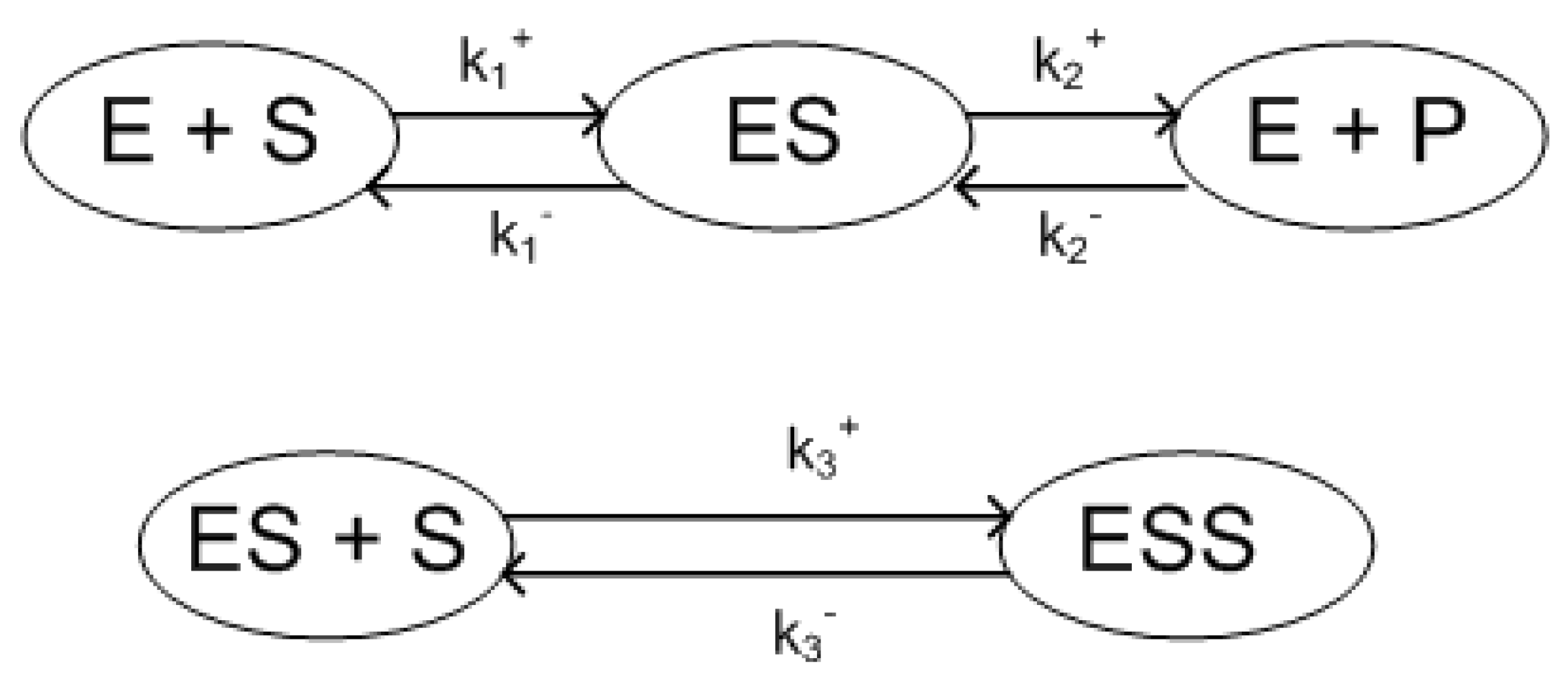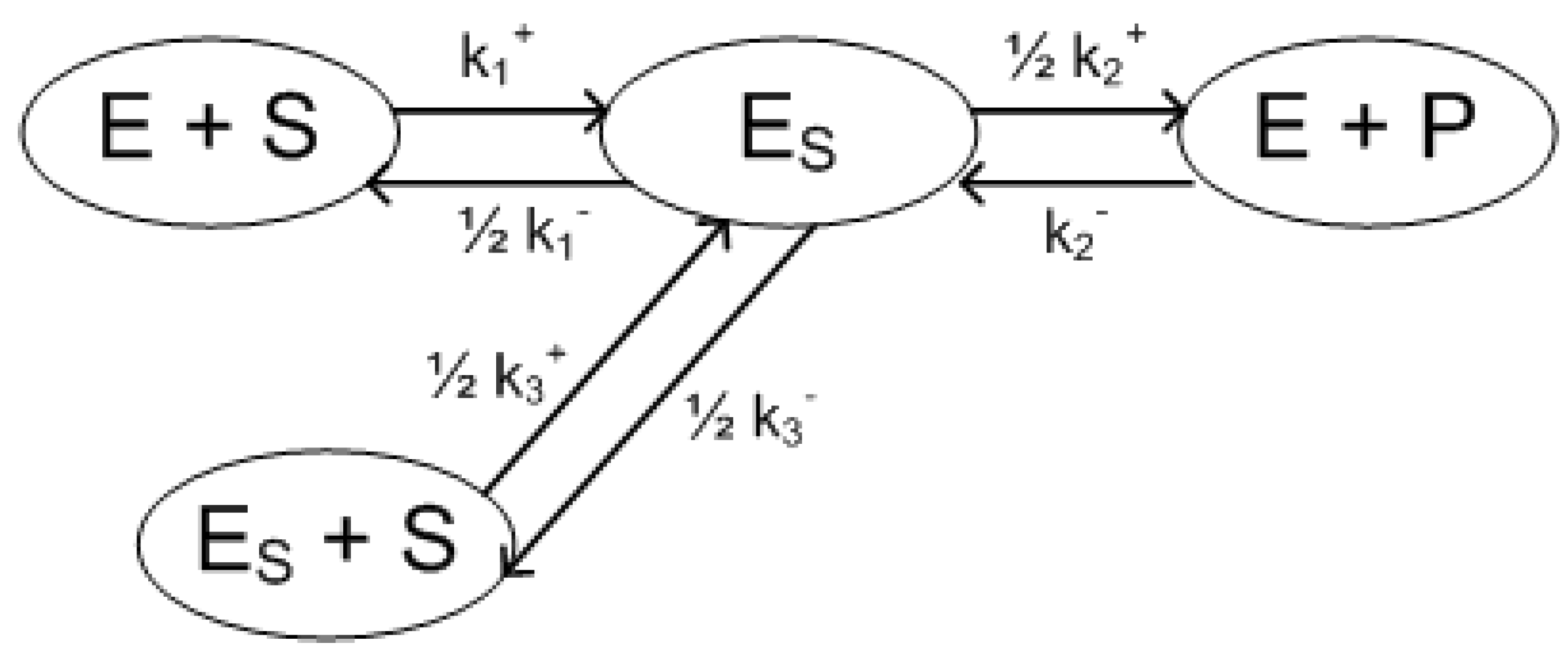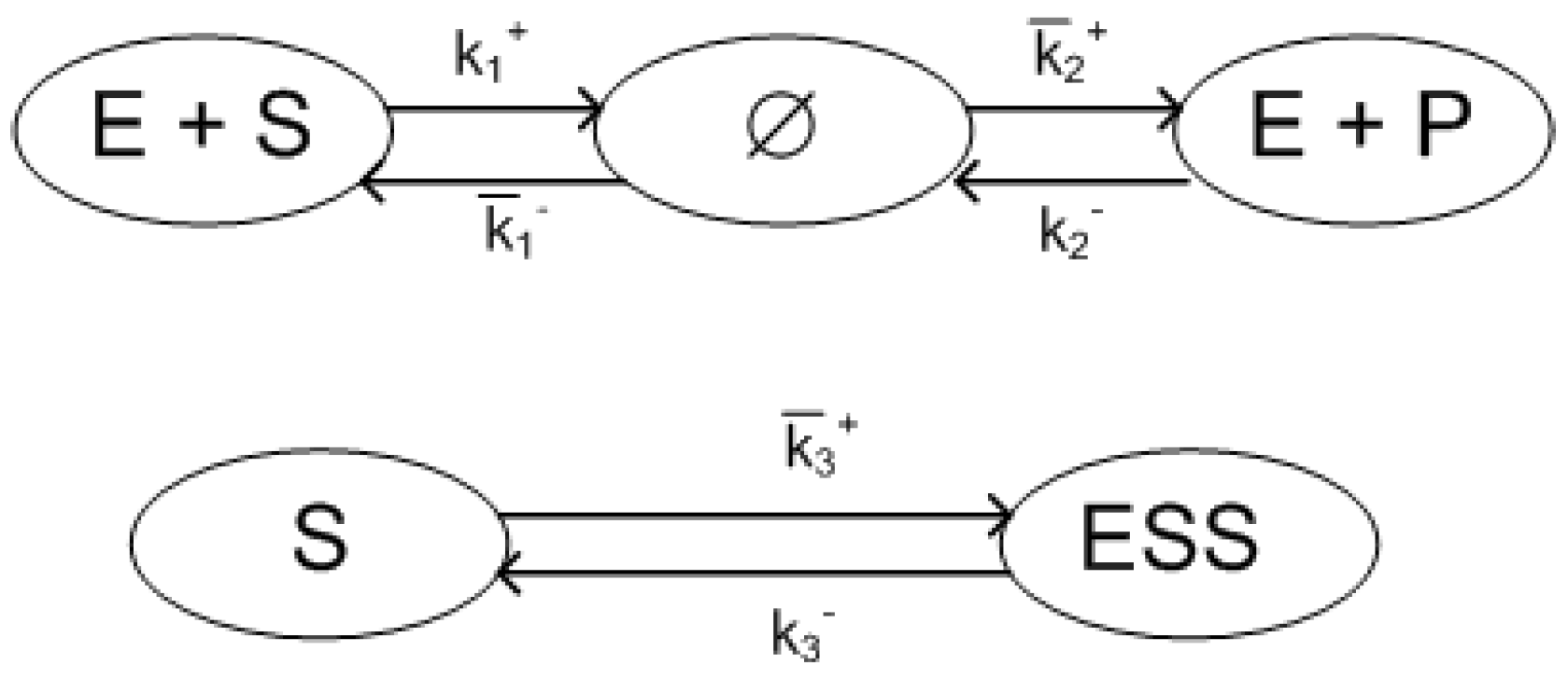Engineering Model Reduction and Entropy-based Lyapunov Functions in Chemical Reaction Kinetics
Abstract
:1. Introduction
2. Reaction Kinetic Model Classes
2.1. General reaction kinetic differential equations
2.2. Mass action law (MAL) kinetics
2.3. MAL kinetics with reversible reactions
2.4. Examples



3. Properties of Reaction Kinetic Models
3.1. Basic properties
3.2. Conservations and first integrals
3.3. Stability
3.4. Properties of the example kinetic systems
4. Model Reduction Using Variable Lumping
4.1. Mathematical and physical characterization
4.2. Effect on the model properties
- L1
- By substituting the lumped variable into the two original ones, each complex that contains them will change. Formally, the nth row is added to the th one, and the nth is deleted, while the number of columns in Y does not change.
- L2,L3
- These steps do not influence the structure of the matrices Y and but implement the changes in the reaction equations caused by step L1. Note that the reaction rate constants in will change.
4.3. Examples

5. Model Reduction Using Quasi Equilibrium and Quasi Steady State Assumptions
5.1. Mathematical and physical characterization
- E1
- introducing a new pseudo concentration variable in the form of
- E2
- substituting the new concentration variable into the terms and whenever they appear,
- E3
- condensing (uniting) the complexes and into a new complex corresponding to the new variable in the reaction graph, and forming a new pseudo component mass balance, i.e. a kinetic equation for by adding together all the RHS functions where any of the terms and appear, and taking its negative.

- SS1
- eliminating the component by setting its concentration to a constant whenever it appears,
- SS2
- substituting the resulting algebraic equation from Equation (51), e.g., into the differential ones.
5.2. Effect on the model properties
- the columns and are deleted from matrix Y, and a new column is inserted being a unit column vector,
- the vertices and in the reaction graph are condensed (united), such that the united remaining vertex inherits every incoming and outgoing directed edges (all reactions) that were adjacent to and . Formally this can be performed by adding the jth row to the th one in the Kirchhoff matrix , and the jth column to the th one (except for the diagonal entries), and then delete the jth row and column (and recompute ).
- SS1
- The row belonging to the component in quasi steady state is deleted from the matrix Y.
- SS2
- The substitution of one reaction monomial into the RHSs using Equation (52) decreases the number of complexes, which implies to delete the column from the matrix Y, to omit the vertex belonging to from the reaction graph, and to introduce directed edges into the graph.
5.3. Examples
- Quasi equilibrium for the reactionThe equation to be used is , the complex is eliminated. The resulting reduced model is in a reaction kinetic formthat remains structurally stable.
- Quasi equilibrium for the reactionHere we use the equation for the reduction, that implies quasi steady state for the component , that is, . In addition, as the reaction forms a connected component in the reaction graph in itself, this connected component disappears from the reaction graph completely. Performing the reduction formally, one obtains the following reduced model in reaction kinetic formthat preserves it structural stability.

- Quasi steady state for the componentLet us denote the steady state value of component by , and let us notice that forms a complex in itself. Therefore, the reduced stoichiometric matrix becomesthat shows that the zero complex appears in the reaction kinetic system (see 2nd column of ). The reduced kinetic equations arewhere the new reaction rate constants are formed as . For the zero complex that appears in the place of there is no component mass balance, but the presence of constant positive terms indicate that the systems becomes open. The reaction graph of the reduced system is seen in Figure 7. It is important to note that structural stability of the reduced model cannot be guaranteed.

- 2
- Quasi steady state for the component EWith the steady state value of component E the transformed reaction rate constants are formed as , and the reduced kinetic equations are as follows.The reduced stoichiometric matrix is nowIt can be easily seen that the algebraic equation (68) restricts the system dynamics to a 3-dimensional manifold in the 4-dimensional component space. However, the reaction kinetic form would be lost if one expresses a variable from Equation (68) and substitutes it into the differential ones because of the appearance of negative cross-effects.At the same time, structural stability of the model remains unchanged, because the reduced “unrestricted model” (Equations (69)–(72)) is in a reaction kinetic form with reversible reactions.
6. Conclusions
Acknowledgements
References
- Érdi, P.; Tóth, J. Mathematical Models of Chemical Reactions. Theory and Applications of Deterministic and Stochastic Models; Manchester University Press, Princeton University Press: Manchester, UK and Princeton, NJ, USA, 1989. [Google Scholar]
- Haag, J.; Wouver, A.; Bogaerts, P. Dynamic modeling of complex biological systems: a link between metabolic and macroscopic description. Math. Biosci. 2005, 193, 2549. [Google Scholar] [CrossRef] [PubMed]
- Sontag, E. Structure and stability of certain chemical networks and applications to the kinetic proofreading model of T-cell receptor signal transduction. IEEE Trans. Autom. Control 2001, 46, 1028–1047. [Google Scholar] [CrossRef]
- Angeli, D. A tutorial on chemical network dynamics. Eur. J. Control. 2009, 15, 398–406. [Google Scholar] [CrossRef]
- Chellaboina, V.; Bhat, S.P.; Haddad, W.M.; Bernstein, D.S. Modeling and analysis of mass-action kinetics – nonnegativity, realizability, reducibility, and semistability. IEEE Control. Syst. Mag. 2009, 29, 60–78. [Google Scholar] [CrossRef]
- Hangos, K.M.; Cameron, I.T. Process Modelling and Model Analysis; Academic Press: London, 2001. [Google Scholar]
- Alonso, A.; Ydstie, B. Process systems, passivity and the second law of thermodynamics. Comp. Chem. Eng 1996, 20, 1119–1124. [Google Scholar] [CrossRef]
- Hangos, K.M.; Alonso, A.A.; Perkins, J.D.; Ydstie, B.E. Thermodynamic approach to the structural stability of process plants. AIChE Journal 1999, 45, 802–816. [Google Scholar] [CrossRef]
- Alonso, A.; Fernandez, C.; Banga, J. Dissipative systems: From physics to robust nonlinear control. Int. J. of Robust Nonlinear Contr. 2004, 14, 157–159. [Google Scholar] [CrossRef]
- Callen, H.B. Thermodynamics and an Introduction to Thermostatistics; John Wiley and Sons: New York, 1980. [Google Scholar]
- Feinberg, M. Lectures on Chemical Reaction Networks; Notes of lectures given at the Mathematics Research Center, University of Wisconsin: Wiscosin, 1979. [Google Scholar]
- Feinberg, M. Chemical reaction network structure and the stability of complex isothermal reactorsI. The deficiency zero and deficiency one theorems. Chem. Eng. Sci. 1987, 42, 2229–2268. [Google Scholar] [CrossRef]
- Tzafiri, A.; Edelman, E. The total quasi-steady-state approximation is valid for reversible enzyme kinetics. J. Theor. Biol. 2004, 226, 303–313. [Google Scholar] [CrossRef]
- Millat, T.; Bullinger, E.; Rohwer, J.; Wolkenhauer, O. Approximations and their consequences for dynamic modelling of signal transduction pathways. Math. Biosci. 2007, 47, 40–57. [Google Scholar] [CrossRef] [PubMed]
- Farkas, G. Kinetic lumping schemes. Chem. Eng. Sci. 1999, 54, 3909–3915. [Google Scholar] [CrossRef]
- Li, G.; Rabitz, H.; Tóth, J. A general analysis of exact nonlinear lumping in chemical kinetics. Chem. Eng. Sci. 1994, 49, 343–361. [Google Scholar] [CrossRef]
- Hárs, V.; Tóth, J. Qualitative Theory of Differential Equations; North Holland, 1981; chapter On the inverse problem of reaction kinetics; pp. 363–379. [Google Scholar]
- Feinberg, M. On chemical kinetics of a certain class. Arch. Rational Mech. Anal. 1972, 46, 1–41. [Google Scholar] [CrossRef]
- Szederkényi, G. Computing sparse and dense realizations of reaction kinetic systems. J. Math. Chem. 2009. to appear, available online. [Google Scholar] [CrossRef]
- Bykov, V.; Gorban, A.N.; Yablonskii, G.; Elokhin, V. Kinetic Models of Catalytic Reactions (Comprehensive Chemical Kinetics, V.32, ed. by R.G. Compton); Elsevier: Amsterdam, 1991. [Google Scholar]
- Angeli, D.; Leenheer, P.; Sontag, E. A Petri net approach to the study of persistence in chemical reaction networks. Math. Biosci. 2007, 210, 598–618. [Google Scholar] [CrossRef] [PubMed]
- Gorban, S.; Gorban, P.; Judge, G. Entropy: the Markov ordering approach. Entropy 2010. to appear. [Google Scholar] [CrossRef]
- Feinberg, M. Necessary and sufficient conditions for detailed balancing in mass action systems of arbitrary complexity. Chem. Eng. Sci. 1989, 44, 1819–1827. [Google Scholar] [CrossRef]
- Leitold, A.; Hangos, K.M.; Tuza, Z. Structure simplification of dynamic process models. J. Process Control 2002, 12, 69–83. [Google Scholar] [CrossRef]
- Szederkényi, G. Computing reaction kinetic realizations of positive nonlinear systems using mixed integer programming. In IFAC Symposium on Nonlinear Control Systems (NOLCOS); 2010. [Google Scholar]
- Szederkényi, G.; Hangos, K.; Magyar, A. On the time-reparametrization of quasi-polynomial systems. Phys. Lett. A 2005, 334, 288–294. [Google Scholar] [CrossRef]
© 2010 by the author; licensee Molecular Diversity Preservation International, Basel, Switzerland. This article is an open-access article distributed under the terms and conditions of the Creative Commons Attribution license http://creativecommons.org/licenses/by/3.0/.
Share and Cite
Hangos, K.M. Engineering Model Reduction and Entropy-based Lyapunov Functions in Chemical Reaction Kinetics. Entropy 2010, 12, 772-797. https://doi.org/10.3390/e12040772
Hangos KM. Engineering Model Reduction and Entropy-based Lyapunov Functions in Chemical Reaction Kinetics. Entropy. 2010; 12(4):772-797. https://doi.org/10.3390/e12040772
Chicago/Turabian StyleHangos, Katalin M. 2010. "Engineering Model Reduction and Entropy-based Lyapunov Functions in Chemical Reaction Kinetics" Entropy 12, no. 4: 772-797. https://doi.org/10.3390/e12040772
APA StyleHangos, K. M. (2010). Engineering Model Reduction and Entropy-based Lyapunov Functions in Chemical Reaction Kinetics. Entropy, 12(4), 772-797. https://doi.org/10.3390/e12040772



